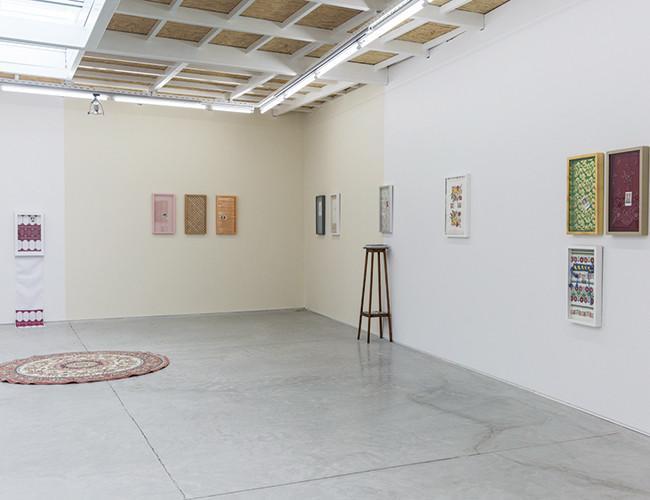
Judging, stereotyping, the hardships of existing in a society and a look at queer culture are the notions one has to think about when looking at the artworks of Huo Rf. The artist’s first solo exhibition, “Stories in Reverse,” looks into social norms, queer culture and the complications of self-expression as an individual. The exhibition at Pi Artworks Gallery is a look through the artist’s life and his comments on the society’s interpretation of queer culture.
The works, which consist of Polaroid photos of male body parts, are merged with fabrics and materials like ribbons, Styrofoam, wood and shirts. Huo Rf calls these Polaroid photos “Homotopia Series.” Men in these photos are not identified. The viewer can see these male body parts from behind and there is nothing that indicates their identities. The artist places the Polaroid photo on a material that the subject chooses.
“Using a Polaroid is a reference to queer culture,” said Huo Rf, adding that Polaroids have also been used by Andy Warhol, to whom he paid homage in his work.
“These photos belong to other people I know, but in a way these are my own stories,” he said, adding that he has taken photos during his travels to other countries.
The Polaroids serve as a witness to Huo Rf’s own history. There lie his own experiences which he tries to tell through using different bodies and different identities.
One has to read between the lines in order to understand these works. Huo Rf tries to give the viewer a new approach in terms of perceiving queer identity.
According to the curator of the exhibition, Nicole O’Rourke, the artist often deals with the complications of being an individual in a society, identity politics and navigating within and without social and/or cultural norms.
“I have taken these photos during my visits to Istanbul, Athens, Lviv, Kyiv, Kharkiv, Tel Aviv, Jerusalem, Vienna, Tbilisi, Belgrade, Sarajevo, Lisbon, Porto and Berlin. I met with these people and they have entered my story and have become a part of it,” the artist said.
In a way Huo Rf tries to question how the queer culture has been ignored in different cultures. Using Polaroid as a means of his artwork or photographing male body parts are all a part of this questioning process. During his visits to different countries, he has also seen many things that have raised new questions. “In Tel Aviv, the queer scene is so live, but in Georgia or Ukraine it is the opposite,” he said.
He tries to highlight the differences in the perceptions of queer culture in different cities. The photos’ timeline is over the course of two years.
“I try to explain the invisibility of queer culture by using different materials. You have to get closer to the works in order to see male body parts,” he added.
It is no coincidence that the artist has chosen to use different materials while installing his Polaroids. The materials he used to merge his Polaroids also belong to a part of his life.
The artist used old materials from the old exhibitions of Hüseyin Bahri Alptekin and Gülsün Karamustafa, who he refers to as “art workers.”
‘‘I have worked in the Rampa Art Gallery for a while and when I was there I had worked in shows of Karamustafa and Alptekin, the two artists who inspire me the most. I have taken used exhibition materials and transformed them to use in my own show,” he said.
The exhibition, which constitutes a strong witness to the artist’s life and identity, also takes a look at the story of others who have touched his life.
The exhibition can be seen at Pi Artworks until Nov. 25.